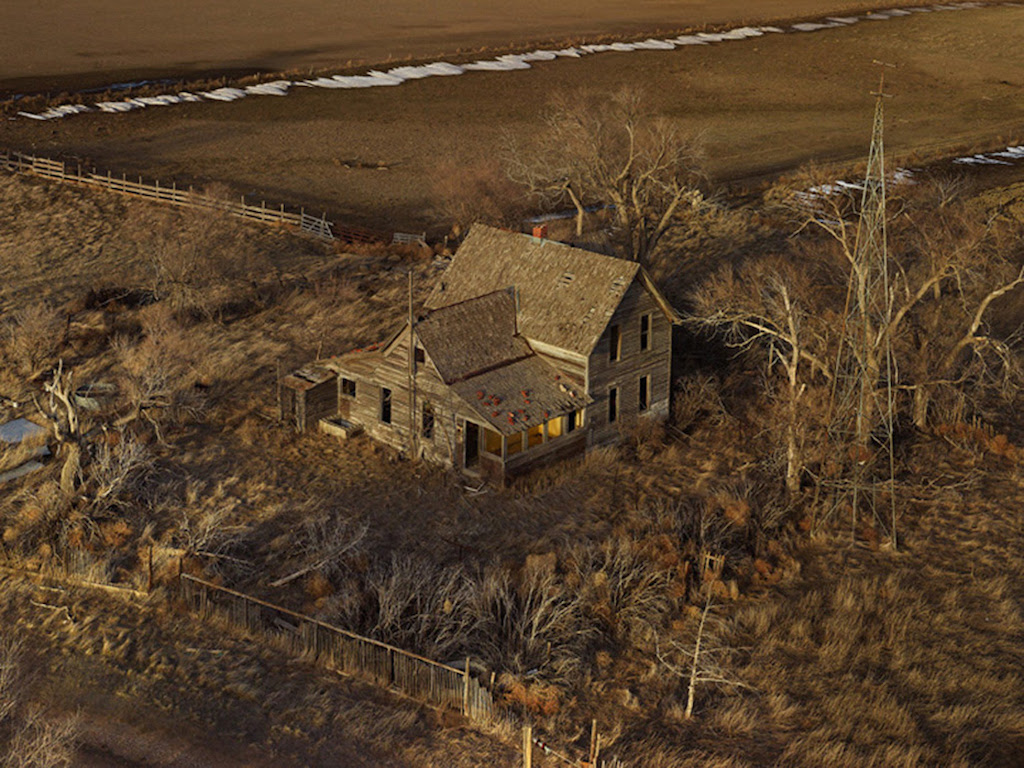
© Andrew Moore, The Yellow Porch, Sheridan County, Nebraska, 2013
Photographer Andrew Moore has worked along the 100th meridian for the past decade, drawn to its mythic past and the people who call the High Plains home. Based out of Rushville, Nebraska, for much of this project, Moore found an unassuming landscape that revealed a long history of challenging weather, repeated drought, and ongoing cycles of economic boom and bust. Set within the context of this demanding legacy, however, he also discovered the vitality of its inhabitants and the elegance of the plains’ spare topography. Although literally the center of the United States, its sparse population teeters between geographic isolation and its prominent role in national and global markets for agriculture, energy, and natural resources. Moore sets this dynamic against the enduring myths of a quintessentially American landscape, balancing the weight of its past against a complex future.
While the frontier is a fluid concept, the 100th meridian has traditionally been understood as the beginning of the American West. Passing through the Dakotas, Nebraska, Kansas, Oklahoma, and Texas, no other longitude carries the geographic weight of the 100th meridian in our national history. The hardwood forests of the East’s mountains and river valleys give way to prairie, and rainfall to its west averages less than twenty inches a year. This arid climate made the traditional 160-acre homestead a practical impossibility. For all of its geographic and cultural importance, however, the 100th meridian still remains a difficult place for most to envision. Lacking the commanding presence of the Rocky Mountains or the Grand Canyon, the landscapes of the 100th meridian could be considered featureless, if one was not paying close attention.
Moore works with both a traditional 8 x 10 inch film camera and a medium-format digital camera, although during this project he discovered a novel way to capture the expanse of the plains landscape. Trying to explore hundreds of square miles on a daily basis, Moore enlisted a pilot in Rushville, Nebraska, to help him get a better sense of the topography. From the cockpit of Doug Dean’s Cessna, Moore was able to scout far beyond what was visible from the road, and Dean’s careful hand could land artist and camera on almost any level field. Soon, the two devised a way to mount Moore’s digital camera under a wing strut, controlled from a laptop in the cockpit. Photographing from this slight elevation gives the sense of being within the landscape rather than above it, a fortuitous solution that enabled Moore to capture the geographic forms and temporal mechanisms of the landscape and reveal the qualities of light, wind, and weather that define the High Plains.
In his carefully woven dialogue of people and place, Moore’s photographs find a consistent, deeply rooted narrative that has been unfolding over the past 150 years. His images sit squarely at the intersection of two lines — the invisible vertical of the 100th meridian and the omnipresent level of the horizon. Imagined together, they map the rise and fall of a subtle topography that runs uninterrupted to the edge of the sky; the endless grind of the wind that abrades the paint from the sides of houses and barns; blizzards that scour barren fields. It is a landscape that requires a direct acceptance of the facts and of its inherent limits, yet it does so with a generosity toward those with the patience to discover the elegance in its simple geometry and quiet perseverance.
The exhibition includes forty-two large-scale color photographs, and is accompanied by the publication Dirt Meridian (Damiani, 2015; $44.95 in the Hitchcock Museum Shop; Member price: $40.46), which includes essays by Toby Jurovics, Joslyn’s Chief Curator and Holland Curator of American Western Art, and Inara Verzemnieks, who has written for publications including The New York Times Magazine and The Atlantic. Kent Haruf, famed author of Plainsong, provided the introduction.

Routing the Pipeline, McKenzie County, North Dakota, 2014, inkjet print, 40 x 53 in., Joslyn Art Museum, gift of the artist, 2016.15.7. © Andrew L. Moore


